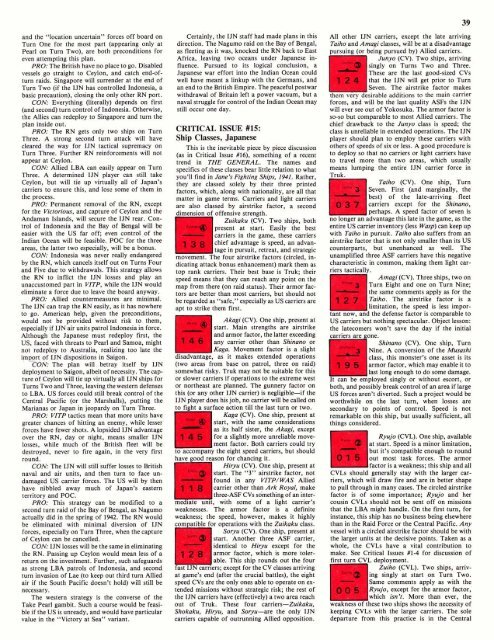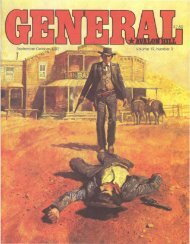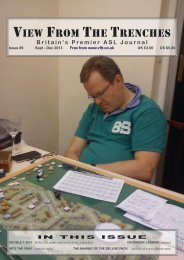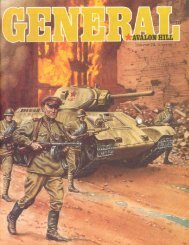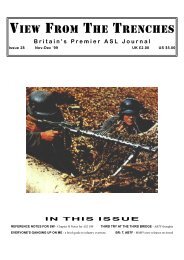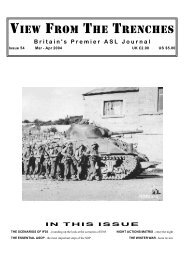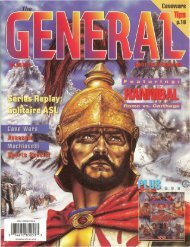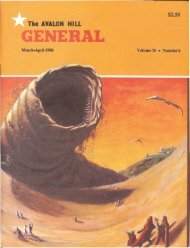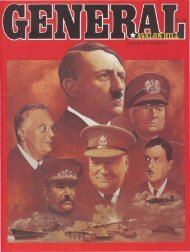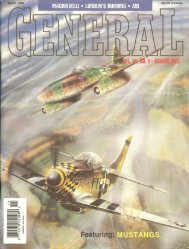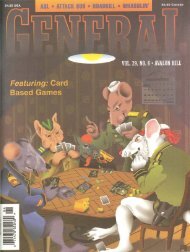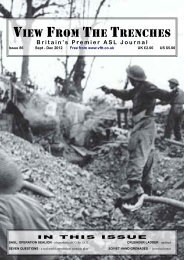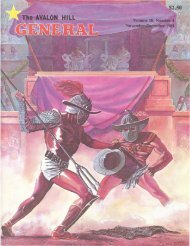18.64MB - View From The Trenches
18.64MB - View From The Trenches
18.64MB - View From The Trenches
- TAGS
- trenches
- www.vftt.co.uk
Create successful ePaper yourself
Turn your PDF publications into a flip-book with our unique Google optimized e-Paper software.
and the "location uncertain" forces off board on<br />
Turn One for the most part (appearing only at<br />
Pearl on Turn Two), are both preconditions for<br />
even attempting this plan.<br />
PRO: <strong>The</strong> British have no place to go. Disabled<br />
vessels go straight to Ceylon, and catch end-of-<br />
turn raids. Singapore will surrender at the end of<br />
Turn Two (if the IJN has controlled Indonesia, a<br />
basic precaution), closing the only other RN port.<br />
CON: Everything (literally) depends on first<br />
(and second) turn control of Indonesia. Otherwise,<br />
the Allies can redeploy to Singapore and turn the<br />
plan inside out.<br />
PRO: <strong>The</strong> RN gets only two ships on Turn<br />
Three. A strong second turn attack will have<br />
cleared the way for IJN tactical supremacy on<br />
Turn Three. Further RN reinforcements will not<br />
appear at Ceylon.<br />
CON: Allied LBA can easily appear on Turn<br />
Three. A determined IJN player can still take<br />
Ceylon, but will tie up virtually all of Japan's<br />
carriers to ensure this, and lost some of them in<br />
the process.<br />
PRO: Permanent removal of the RN, except<br />
for the Victorious, and capture of Ceylon and the<br />
Andaman Islands, will secure the IJN rear. Con-<br />
trol of Indonesia and the Bay of Bengal will be<br />
easier with the US far off; even control of the<br />
Indian Ocean will be feasible. POC for the three<br />
areas, the latter two especially, will be a bonus.<br />
CON: Indonesia was never really endangered<br />
by the RN, which cancels itself out on Turns Four<br />
and Five due to withdrawals. This strategy allows<br />
the RN to inflict the IJN losses and play an<br />
unaccustomed part in VITP, while the IJN would<br />
eliminate a force due to leave the board anyway.<br />
PRO: Allied countermeasures are minimal.<br />
<strong>The</strong> IJN can trap the RN easily, as it has nowhere<br />
to go. American help, given the preconditions,<br />
would not be provided without risk to them,<br />
especially if IJN air units patrol Indonesia in force.<br />
Although the Japanese must redeploy first, the<br />
US, faced with threats to Pearl and Samoa, might<br />
not redeploy to Australia, realizing too late the<br />
import of IJN dispositions in Saigon.<br />
CON: <strong>The</strong> plan will betray itself by IJN<br />
deployment to Saigon, albeit of necessity. <strong>The</strong> cap-<br />
ture of Ceylon will tie up virtually all IJN ships for<br />
Turns Two and Three, leaving the western defenses<br />
to LBA. US forces could still break control of the<br />
Central Pacific (or the Marshalls), putting the<br />
Marianas or Japan in jeopardy on Turn Three.<br />
PRO: VITP tactics mean that more units have<br />
greater chances of hitting an enemy, while lesser<br />
forces have fewer shots. A lopsided IJN advantage<br />
over the RN, day or night, means smaller IJN<br />
losses, while much of the British fleet will be<br />
destroyed, never to fire again, in the very first<br />
round.<br />
CON: <strong>The</strong> IJN will still suffer losses to British<br />
naval and air units, and then turn to face un-<br />
damaged US carrier forces. <strong>The</strong> US will by then<br />
have nibbled away much of Japan's eastern<br />
territory and POC.<br />
PRO: This strategy can be modified to a<br />
second turn raid of the Bay of Bengal, as Nagumo<br />
actually did in the spring of 1942. <strong>The</strong> RN would<br />
be eliminated with minimal diversion of IJN<br />
forces, especially on Turn Three, when the capture<br />
of Ceylon can be cancelled.<br />
CON: IJN losses will be the same in eliminating<br />
the RN. Passing up Ceylon would mean less of a<br />
return on the investment. Further, such safeguards<br />
as strong LBA patrols of Indonesia, and second<br />
turn invasion of Lae (to keep out third turn Allied<br />
air if the South Pacific doesn't hold) will still be<br />
necessary.<br />
<strong>The</strong> western strategy is the converse of the<br />
Take Pearl gambit. Such a course would be feasi-<br />
ble if the US is unready, and would have particular<br />
value in the "Victory at Sea" variant.<br />
Certainly, the IJN staff had made plans in this<br />
direction. <strong>The</strong> Nagumo raid on the Bay of Bengal,<br />
as fleeting as it was, knocked the RN back to East<br />
Africa, leaving two oceans under Japanese in-<br />
fluence. Pursued to its logical conclusion, a<br />
Japanese war effort into the Indian Ocean could<br />
well have meant a linkup with the Germans, and<br />
an end to the British Empire. <strong>The</strong> peaceful postwar<br />
withdrawal of Britain left a power vacuum, but a<br />
naval struggle for control of the Indian Ocean may<br />
still occur one day.<br />
CRITICAL ISSUE #15:<br />
Ship Classes, Japanese<br />
This is the inevitable piece by piece discussion<br />
(as in Critical Issue #16), something of a recent<br />
trend in THE GENERAL. <strong>The</strong> names and<br />
specifics of these classes bear little relation to what<br />
you'll find in Jane's Fighting Ships, 1941. Rather,<br />
they are classed solely by their three printed<br />
factors, which, along with nationality, are all that<br />
matter in game terms. Carriers and light carriers<br />
are also classed by airstrike factor, a second<br />
dimensic F offensive strength.<br />
r_:<br />
Zuikaku (CV). Two ships, both<br />
present at start. Easily the best<br />
carriers in the game, these carriers<br />
chief advantage is speed, an advantage<br />
in pursuit, retreat, and strategic<br />
movement. <strong>The</strong> four airstrike factors (circled, indicating<br />
attack bonus enhancement) mark them as<br />
top rank carriers. <strong>The</strong>ir best base is Truk; their<br />
speed means that they can reach any point on the<br />
map from there (on raid status). <strong>The</strong>ir armor factors<br />
are better than most carriers, but should not<br />
be regarded as "safe," especially as US carriers are<br />
apt to strike them first.<br />
Akagi (CV). One ship, present at<br />
start. Main strengths are airstrike<br />
and armor factor, the latter exceeding<br />
any carrier other than Shinano or<br />
Kaga. Movement factor is a slight<br />
disa , as it makes extended operations<br />
(two areas from base on patrol, three on raid)<br />
somewhat risky. Truk may not be suitable for this<br />
or slower carriers if operations to the extreme west<br />
or northeast are planned. <strong>The</strong> gunnery factor on<br />
this (or any other IJN carrier) is negligible-if the<br />
IJN player does his job, no carrier will be called on<br />
1<br />
to fight a surface action till the last turn or two.<br />
Kaga (CV). One ship, present at<br />
start, with the same considerations<br />
as its half sister, the Akagi, except<br />
for a slightly more unreliable move-<br />
ment factor. Both carriers could try<br />
to accompany the eight speed carriers, but should<br />
have good reason for chancing it.<br />
Hiryu (CV). One ship, present at<br />
I s t a r t . <strong>The</strong> "3" airstrike factor, not<br />
found in any VITP/WAS Allied<br />
carrier other than Ark Royal, make<br />
three-ASF CVs something of an inter-<br />
mediate unit, with some of a light carrier's<br />
weaknesses. <strong>The</strong> armor factor i; a definite<br />
weakness; the speed, however, makes it highly<br />
r<br />
compatible for operations with the Zuikaku class.<br />
Soryu<br />
(CV). One ship, present at<br />
start. Another three ASF carrier,<br />
identical to Hiryu except for the<br />
armor factor, which is more toler-<br />
able. This ship rounds out the four<br />
ers; except for the CV classes arriving<br />
at game's end (after the crucial battles), the eight<br />
speed CVs are the only ones able to operate on ex-<br />
tended missions without strategic risk; the rest of<br />
the IJN carriers have (effectively) a two area reach<br />
out of Truk. <strong>The</strong>se four carriers-Zuikaku,<br />
Shokaku, Hiryu, and Soryu-are the only IJN<br />
carriers capable of outrunning Allied opposition.<br />
All other IJN carriers, except the late arriving<br />
:<br />
Taiho and Amagi classes, will be at a disadvantage<br />
J<br />
'<br />
)r being pursued by) Allied carriers.<br />
Junyo (CV). Two ships, arriving<br />
singly on Turns Two and Three.<br />
<strong>The</strong>se are the last good-sized CVs<br />
that the IJN will get prior to Turn<br />
Seven. <strong>The</strong> airstrike factor makes<br />
th {erj desirable additions to the main carrier<br />
forces, and will be the last quality ASFs the IJN<br />
will ever see out of Yokosuka. <strong>The</strong> armor factor is<br />
so-so but comparable to most Allied carriers. <strong>The</strong><br />
chief drawback to the Junyo class is speed; the<br />
class is unreliable in extended operations. <strong>The</strong> IJN<br />
player should plan to employ these carriers with<br />
others of speeds of six or less. A good procedure is<br />
to deploy so that no carriers or light carriers have<br />
to travel more than two areas, which usually<br />
means lumping the entire IJN carrier force in<br />
1<br />
Taiho (CV). One ship, Turn<br />
' Seven. First (and marginally, the<br />
best) of the late-arriving fleet<br />
carriers except for the Shinano,<br />
J perhaps. A speed factor of seven is<br />
nc n advantage this late in the game, as the<br />
entire US carrier inventory (less Wasp) can keep up<br />
with Taiho in pursuit. Taiho also suffers from an<br />
airstrike factor that is not only smaller than its US<br />
counterparts, but unenhanced as well. <strong>The</strong><br />
unamplified three ASF carriers have this negative<br />
characteristic in common, making them light carriers<br />
tactically.<br />
1<br />
Amagi (CV). Three ships, two on<br />
Turn Eight and one on Turn Nine;<br />
the same comments apply as for the<br />
Taiho. <strong>The</strong> airstrike factor is a<br />
I limitation, the speed is less impornow,<br />
and the defense factor is comparable to<br />
US carriers but nothing spectacular. object lesson:<br />
the latecomers won't save the day if the initial<br />
Shinano (CV). One ship, Turn<br />
Nine. A conversion of the Musashi<br />
i<br />
class, this monster's one asset is its<br />
armor factor, which may enable it to<br />
last long enough to do some damage.<br />
It can be employed singly or without escort, or<br />
both, and possibly break control of an area if large<br />
US forces aren't diverted. Such a project would be<br />
worthwhile on the last turn, when losses are<br />
secondary to points of control. Speed is not<br />
remarkable on this ship, but usually sufficient, all<br />
&L:--. .--. :>.ed<br />
.<br />
Ryujo (CVL). One ship, available<br />
t start. Speed is a minor limitation,<br />
ut it's compatible enough to round<br />
ut most task forces. <strong>The</strong> armor<br />
ictor is a weakness; this ship and all<br />
LVLS snuulu generally stay with the larger car-<br />
riers, which will draw fire and are in better shape<br />
to pull through in many cases. <strong>The</strong> circled airstrike<br />
factor is of some importance; Ryujo and her<br />
cousin CVLs should not be sent off on missions<br />
that the LBA might handle. On the first turn, for<br />
instance, this ship has no business being elsewhere<br />
than in the Raid Force or the Central Pacific. Any<br />
vessel with a circled airstrike factor should be with<br />
the larger units at the decisive points. Taken as a<br />
whole, the CVLs have a vital contribution to<br />
make. See Critical Issues #I-4 for discussion of<br />
first turn CVL deployment.<br />
Zuiho (CVL). Two ships, arriv-<br />
ing singly at start on Turn Two.<br />
Same comments apply as with the<br />
Ryujo, except for the armor factor,<br />
which isn't. More than ever, the<br />
weakness of these two ships shows the necessity of<br />
keeping CVLs with the larger carriers. <strong>The</strong> sole<br />
departure from this practice is in the Central


